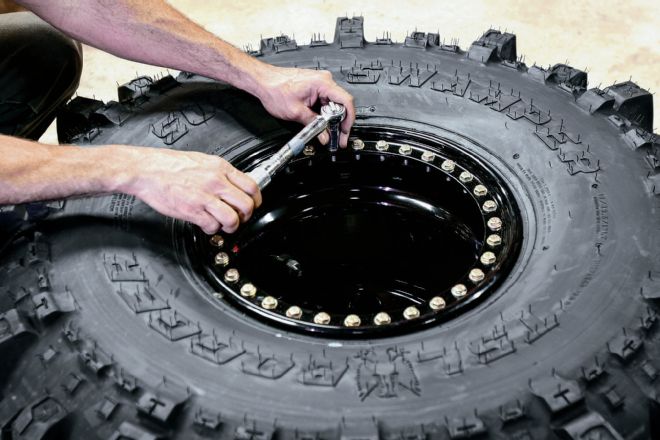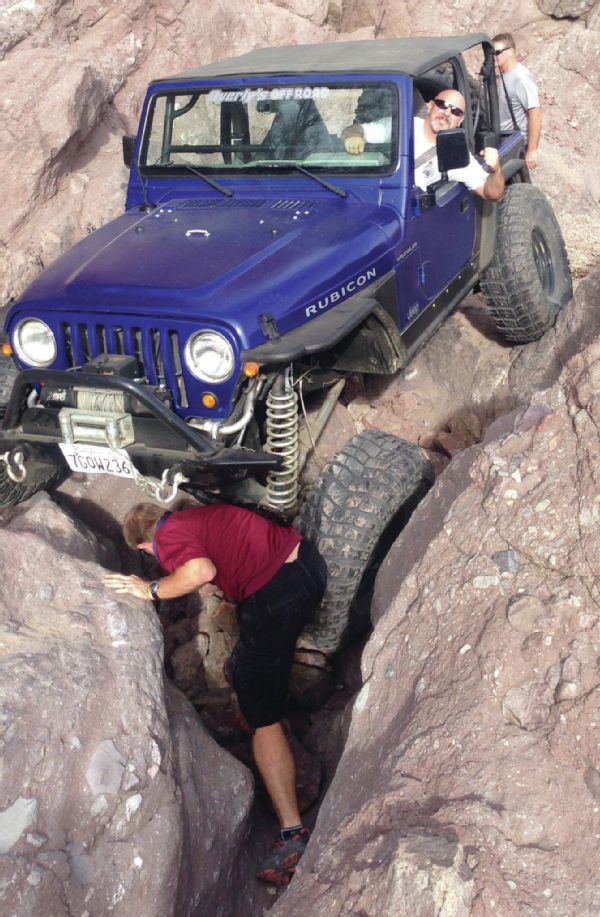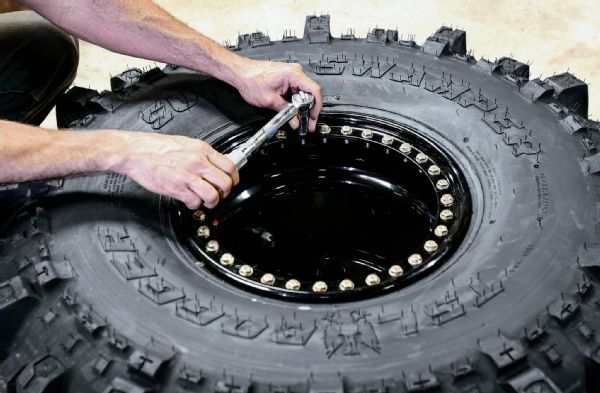
 John Cappa
Former Editor, Four Wheeler
John Cappa
Former Editor, Four Wheeler
Struts And Straps
Q The story “GI Gyp” (Dec. ’14) was an eye opener as everyone talks about the gas-filled bumpstops. The article made me think of a couple of related topics, including the use of limit straps and shocks versus coilovers versus struts.
In my included pic, you’ll see why I bring up the desire to know about limit straps. The driver-side front suspension drooped into a crevasse so big that someone could walk in it. I’m guessing that the axle hanging that low is dangerous for driveshaft longevity.
Another cool article would be about shocks versus coilovers versus struts. Reason being is that after I managed to get out of that crater, a Jeep with coilovers made it look easy. I’m guessing that going to coilovers and mounting them outside the frame would be a relatively cheap upgrade, but for slow rockcrawling, would the expense of ORI struts be worth it? I hear that with ORI struts you can eliminate a bunch of things like bumpstops, limit straps and sway bars, but at $1,400 for two, they are not cheap.
Also, how the heck do you know how long a limit strap should be and how do you measure how long a shock with a raised mount should be? I figure these are topics a lot of people would be interested in.
Thanks again for helping those of us who are doing our damnedest to get out into the wild blue yonder.
Alfred Ricci
Via email

A Coilover shocks have garnered a lot of attention from the enthusiast market over the last several years as the shocks became more affordable. Unfortunately, it’s nearly impossible to attribute ultimate success over a particular section of trail to one specific component of your vehicle. There is so much more to consider including weight, center of gravity, and the fact that taking a line that is only 1 or 2 inches to the right or left can provide incredibly different results.
ORI (oristruts.com) STX struts are nitrogen air shocks with externally adjustable rebound valving, three-stage compression stoke with built-in hydraulic and mechanical bumpstops, and park-position tuning for reduced unloading. Each strut is designed to support up to 1,300 pounds, which makes them ideal for lightweight 4x4s. On larger vehicles, multiple struts can be installed independently or even interconnected to act as one unit. ORI struts have some distinct advantages over coilovers and conventional nitrogen shocks. When tuned properly, they can be a lot more stable and provide more predictable suspension movement, especially in precarious situations like the one you have pictured. Even though the ORI struts have built-in bumpstops, I would still recommend at least a small thin bumpstop that makes contact at full compression to help dissipate any heavy loads that could bend or break the mounting bolts or damage whatever strut mounts that you fabricate. I’d also recommend using limit straps for the same reason. When ORI struts are properly adjusted, you can eliminate the need for a sway bar.
When selecting limit straps you need to inspect the suspension and drivetrain under your 4x4 very closely. You should cycle the suspension and find out when and where components like driveshaft yokes and shocks bind or top out. Once you find that location, you can identify a suitable spot to mount the limit straps and mounting tabs. Take a measurement between the eyeholes of the mounting tabs. Most limit straps will stretch up to 1 inch per foot of length under heavy use, so subtract an inch from whatever measurement you take before ordering your limit straps.
Selecting your shock length can be done similarly. You need to consider upper and lower shock mounting locations when you cycle the suspension. Make sure there is plenty of room for the tires to compress into the wheelwells. Most people make the mistake of ordering shocks that are too long for their application. This often results in costly returns, overly tall vehicle builds, and the need for holes in the body panels for the shocks to pop through. Don’t become too fixated on a specific shock length—buy what fits. In the end, the additional wheel travel afforded by the overly long shocks seldom outweighs the drawbacks of making them work in too confined of a space.
Chevy Spinning
Q Is there a kit to make my ’03 Chevy ZR2 driver-side tire into having power like passenger side? When I turn on four-wheel drive, I want power at all four tires.
Mike Stiffler
Via email
A What you are experiencing is the drawback of an open differential. An open differential leaves a lot to be desired when encountering staggered holes or slippery surfaces off-road. You have likely put your vehicle in a situation where two tires (one front and one rear) spin uselessly and the tires that have traction don’t move. Nothing is wrong with the vehicle. Installing traction-adding devices in the axles will keep this from happening. The traction-adding devices will split the torque to both tires. If you go with a locker in one or (better yet) both axles, you’ll have 100 percent of the engine’s torque available at each tire, regardless of the terrain. Now, the problem is that there aren’t any lockers available for the frontend of your 4x4. The IFS frontend and steering system is generally considered to be too weak to handle the added traction of a locker. In the rear you have several traction-adding options. Check out “Making Traction” online at fourwheeler.com to help you decide which traction-adding device is right for you.
Beadlegal or Not
Q As a long-time reader, very long-time wheeler, and president of a 41-year-old Colorado-based 4x4 club, I am confused by conflicting information I’ve read recently. In “Beadlock Input” (May ’15), John Cappa writes that clamp-on style beadlock wheels, such as ATX, Champion, TrailReady, and so on “are generally not D.O.T. compliant (not street legal)”. However, in the June ’15 issue of your sister publication (4-Wheel & Off-Road), in “Top 10 4x4 Myths,” myth number six reads “Beadlock Wheels Are Not D.O.T. Approved: TrailReady, B.A.D., Raceline, and so on, all make D.O.T.-approved aluminum beadlock rims that are cast specifically as a beadlock” and “The D.O.T. does not have any regulations directly related to beadlock rims”.
It has long been understood by most in the 4x4 community that our beadlocks make our rigs illegal on the street, but that enforcement is rare. While it is certainly prudent to error on the conservative side, it would be nice to know what the real truth is.
John “Mad Cow” Hembel
HiCountry 4 Wheelers

Via email
A Unfortunately (or fortunately for Four Wheeler), 4-Wheel & Off-Road is misinformed on a few things. First, the Department of Transportation (D.O.T.) does not approve or reject any wheel for on-road use. The D.O.T. simply has a set of guidelines, specs, and measurements that street legal wheels need to adhere to. Wheels can only be D.O.T. compliant or not. There is no stamp of approval from the D.O.T. on the wheel. Second, and most important is that the D.O.T. wheel specifications are very specific about the design and dimensions of a compliant wheel. Just because the wheel is cast with the beadlock lip, does not make it D.O.T.-compliant. The D.O.T. specifies the dimensions and design of the bead area, the arc, and the thickness of the safety bead where the tire is seated. Anything outside the specified parameters is not considered D.O.T.-compliant and therefore not useable for street use in most cases. As you are aware, most clamp-on beadlock wheels feature a significantly different bead-retention design than a traditional wheel with a standard D.O.T.-compliant safety bead. Now, none of this necessarily means that clamp-on beadlock wheels are unsafe for street use. They simply don’t match a set of specifications that the D.O.T. says meet compliance.
Most states are pretty flexible when it comes to beadlock wheels. We have really only run into a few officers in Moab that seem to care about beadlock legality, and interestingly enough, only during the week of Easter Jeep Safari. Now, what is really interesting is that some law-enforcement officers have told us that they cannot write an equipment violation for something like beadlock wheels if you are not in the state your vehicle is registered. That means if you are from out of state, it may not be legal for a Utah officer to write you a ticket for something like using beadlock wheels on the street. Your vehicle could be perfectly legal in the state it’s registered, the officer would not know, because different states often have different laws. However, it’s probably not a great idea to argue with the officer at the time of the ticket. It’s said that a good officer can find up to three equipment violations on even a brand-new vehicle still sitting on the dealer lot. No point in letting an argument lead to your vehicle getting impounded. That said, be sure to educate yourself and possibly fight the ticket on the back end. The good news is if you don’t want to get hassled at all, there are many D.O.T.-compliant beadlock wheels and inner tires available that will keep your tires from unseating at low pressures.
Go Big?
Q I live in Colorado and own a ‘97 4x4 Dodge Ram 2500 with a 12-valve Cummins and a five-speed manual transmission. The truck has a Dana 80 rearend and Dana 60 frontend. It’s lifted 5-6 inches and sits on 35-inch tires. It needs transfer case work, the steering box replaced, and a clutch. Should I fix these issues, put 40s on it, and wheel it? It’s already beat up, so body damage isn’t an issue, but it is big and heavy and the trails can be tight in Colorado. Or, should I sell it and build something smaller?
I will have a mildly built Jeep XJ Cherokee with 33-inch tires to go camping in and do easier trails. I like how the Dodge would be different, but like I said, I don’t want it to be too big to do some of the harder trails. I figured you might have some good advice, since you owned a ’73 J-2000 on 49-inch tires. Thanks for your advice.
Patrick Kolterman
Via facebook.com/JohnCappa4x4
A It really comes down to personal preference. Personally, I like the idea of driving a fullsize truck on the trail. You instantly stand out from a sea of modified JK Jeep Wranglers. You can also carry quite a bit more gear and firewood for camping, repairs, and recovery. However, the truck you have is somewhat desirable for those that love the 12-valve Cummins engine backed up with a manual transmission for towing. Some people might consider it a sin to beat it up on the trail, depending on how beat up the body already is. Something to keep in mind is that the issues you have with the Dodge are known, and relatively easy to fix. You won’t need to make many strength upgrades because the truck essentially already has 1-ton running gear. If you buy another 4x4 to build up, it could have several unknown issues that you’ll have to find out about and fix. A smaller rig will also require a few axle and other upgrades. Now, if it were mine and the body was fairly clean, I might consider fixing the minor issues and make it my tow rig. But if it’s beat up and rusty, maybe consider adapting an M101A2 military trailer bed for more clearance and make it a really cool and original-looking trail rig.
Throttle Stick
I have a tech issue on my ’04 Jeep Rubicon. The throttle keeps sticking intermittently at 2,000 rpm when driving. I have replaced the IAC, TPS, and MAP. All vacuum lines are connected and serviceable. The rpm returns to normal when you stab the throttle. There are no codes. The cable seems to be moving freely. Any tips to get it unstuck? Where can I get another throttle body if I need one? I’m not thrilled at the idea of dropping $600 on a new throttle body.
Darek Connole
Via facebook.com/JohnCappa4x4
A It really sounds like something is hanging up the pedal, cable, or linkage. I’d double check all of that. Carpet and floor mats can get wadded up around the throttle pedal, the cable can get sticky, and debris like sticks and leaves could cause the linkage to get hung up. It’s also possible that the throttle shaft is gummed up and sticking. While unlikely, there might be a solenoid that bumps up the throttle when the A/C is on. Maybe check and see if that’s sticking.
If you find that you need a new throttle body, you can locate good used ones for far less than $600. Your best bet is to call a local Jeep-specific wrecking yard or hit eBay (ebay.com). Good used 4.0L throttle bodies should be easy to come by. I’ve seen them priced anywhere from $25 to $50 on eBay.
Manual to Auto Swap
Q I own a ’71 Ford Bronco with the original three-speed manual transmission and transfer case. I would like to swap in an automatic tranny. What would be the best setup without a lot of changes underneath? I know that the C4 was available in some Broncos, but they are very hard to find.
Lisa and Doug Letteer
Via email
A The ’73-’77 early Broncos had the option of a C4 automatic transmission. James Duff (jamesduff.com), Jeff’s Bronco Graveyard (broncograveyard.com), and Wild Horses (wildhorses4x4.com) all offer parts to help make the swap to an automatic transmission. Before purchasing a transmission, be sure to talk to one of these companies since not all C4 transmissions can be adapted easily to your Bronco. Other components you’ll need include the proper flexplate, torque converter, starter, transmission cooler, transmission lines, shifter, transfer case input shaft, Neutral safety switch, and pedal assembly. You may also need a new carburetor to make use of the throttle kick-down. There are many smaller items that add up when making a swap like this.
Where to Write
Have a 4x4 tech question you want answered in Techline, drop an email to editor@fourwheeler.com or head on over to our forums at fourwheeler.com. All letters become the property of Four Wheeler, and we reserve the right to edit them for length, accuracy, and clarity. Due to the volume of mail, electronic and otherwise, we cannot respond to every reader, but we do read everything.